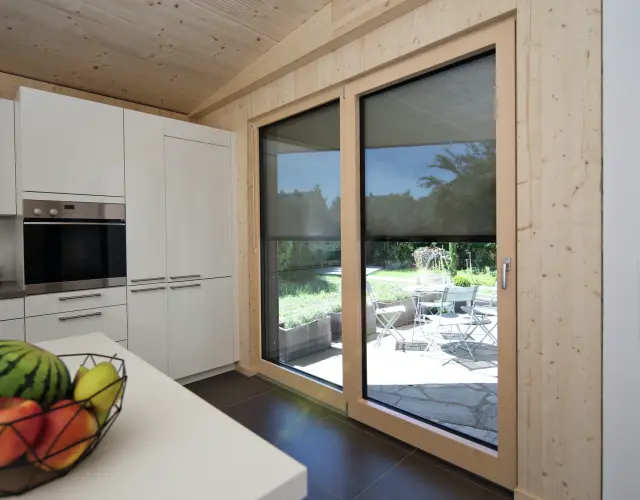
A question of visibility Warema screens in new designs and with different openness factors for user-oriented visual privacy and glare control.
When you use Warema window awnings to shade your rooms, you can decide how much visibility you want to keep through your windows. With the newly designed screen fabrics, various openness factors are possible from completely opaque to perfectly see-through. For example, you can keep your bedroom dark while using glare control in your office or living room to let you look out even when the screen is closed.
With visual privacy and glare control for windows, the screen is always supposed to prevent strangers from looking in and protect against overpowering sunlight without sacrificing the view of the outside. The solution is screens with a black-out level (openness factor) that allows both to be achieved at the same time. They keep your private space private and dim the sunlight while also allowing visual contact with the outside thanks to a fabric mesh size that is not completely opaque – ideal for the living room. These days, however, optimal dim-out is also preferred for both bedrooms and children’s rooms with an openness factor (OF) of 0%. This is clearly a case for Warema, with a collection of screen fabrics that includes not just new designs, but different openness factors of between 0% and 5%.
0% openness factor – a screen almost like a roller shutter
If you don’t want to compromise on optimal black-out or privacy for your room, but you’d prefer a screen to a roller shutter, then you need Warema window awnings with easyZIP guidance and a screen with an OF of 0% – when the screen is closed, the room will be as dark as possible. This means:
- almost no incidence of energy from the sun,
- no glare (glare control class 4 with all fabrics),
- no incidence of daylight and
- no visual contact with the outside.
This also means, however, that to find your way around the room, you will need artificial light or to leave the screen slightly open. This also limits sun shading efficiency, so a higher openness factor may be the better option in specific cases, particularly as there is absolutely no visual contact with the outside when the screen is completely closed. It would be the same if a roller shutter were completely lowered.
1% openness factor – glare control with a view out
If diffuse dim-out is sufficient – with the advantage that you don’t have to sacrifice visual contact with the outside – then a screen is recommended with an OF of 1%. This is ideal for bathrooms, offices and work spaces if visual privacy and glare control is required but you don’t want to isolate yourself from the outside world. The advantages of this are:
- good glare control with a view of the outside,
- lower incidence of energy than with an OF of 4% to 5%,
- fabrics fulfil glare control class 3, and
- view out combined with visual privacy.
Glare will only occur with screens with an OF of 1% if the facade alignment is unfavourable. Light transmission will be low, but still there.
4% or 5% openness factor – visual privacy with optimal daylight usage
An ideal screen for the living room when you want to look out at nature but insist on a certain level of visual privacy. And when the screen is closed, you still want enough daylight in the room to do without artificial light. Screens with an OF of 4% or 5% feature:
- high incidence of energy, although dark fabrics still offer good Fc values,
- significantly reduced glare control (class 0 or 1 in accordance with DIN EN 14501:2021-09),
- a good view out with simultaneous visual privacy (depending on the screen and colour),
- and a larger selection of colours than with screens with an OF of 0% or 1%.
So these screens are not suitable for glare control, although the window’s alignment and direction of view play a role here. However, screens with an OF of 4% or 5% are suitable for use in all rooms that do not require black-out (bedrooms) or glare control (offices).
The greater openness factor, the greater incidence of energy
With an external fabric sun shading system, the incidence of energy depends mainly on radiation transmission, which is made up of direct and diffuse transmission. Direct transmission depends on the openness factor of the screen: the greater the openness factor, the greater the direct incidence of energy and, accordingly, the lower the impact of the sun shading. Meanwhile, the colour of the fabric influences diffuse transmission. The lighter the colour, the more radiation is reflected by the fabric, and the heat energy enters the room as diffuse radiation. The effectiveness of the sun shading is reduced accordingly. For example, glazing of g = 0.53 and Ug = 0.6 with a white-grey screen will produce the following sun shading factors (Fc) depending on the openness factor:
- OF 5%, design 3503 --> Fc = 0,15;
- OF 1%, design 3103 --> Fc = 0,11;
- OF 0%, design 3003 --> Fc = 0,06.
There is no radiation transmission with blackout screens (0%), which means that reflection is the decisive factor here. The greater the reflection, the less the sun shading/glazing system heats up and the lower the incidence of energy. This is why light colours are preferred over dark here for sun shading.
The higher the direct transmittance, the better the view out
It’s logical really: as the fabric mesh size increases, and with it the openness factor, the screen becomes more see-through. This also means that the more diffuse the transmission, the weaker the contrast with the outside, and the weaker the view out. Light, reflective colours have less view out than darker colours.
The lower the transmission, the better the glare control
The protective effect of a screen against glare depends on both the direct and diffuse transmission – the lower these values, the less disruptive light gets through the fabric. The likelihood of glare decreases and/or the screen achieves a higher glare protection class. The higher the glare protection class, the better the visual comfort. This is why low openness factors and dark screen colours are necessary for glare control. DIN EN 14501:2021-09 uses Daylight Glare Probability (DGP) to determine the glare protection class. Since this change, direct transmission (approximately equivalent to the openness factor) must be no more than 3% to maintain class 3 or higher.
The stuff that dream screens are made of
Screen fabrics are made up of PVC-coated glass fibre yarns woven into a textile surface and set using thermal treatment. The special PVC coating ensures high dimensional stability, which pays off because the warmth in the window area puts the fabric at risk of deformation. A further advantage of the open screen fabric is the high degree of transparency with simultaneous sun shading and glare control. High resistance to UV rays ensures that the colour continues to shine. Warema provides a wide range of suitable designs in its window awning collection for all requirements and personal preferences.
The Warema window awning collection
When you’re planning high-quality window awnings, Warema doesn’t just offer a wide range of aesthetic designs – it also meets the most exacting functional standards. The sophisticated technology used for the window awnings effectively protects against sunlight incidence, minimises energy consumption and plays a major role in the look of the facade. Warema’s window awning collection inspires customers with a wide range of designs, colours and fabric properties.
Note on image usage:
The use of the unchanged images is only permitted in the context of the respective press release and exclusively for editorial reporting on WAREMA products, not for advertising purposes. Please use "Copyright WAREMA" as the correct acknowledgment of the source. Please send a digital specimen copy.
Downloads
From completely opaque to the perfect view out – Warema’s current screen fabrics are available with various openness factors
0 % Öffnungsfaktor – ein Screen fast wie ein Rollladen
1 % Öffnungsfaktor – Blendschutz mit Durchblick
4 % Öffnungsfaktor – Sichtschutz mit optimaler Tageslichtausbeute
View and privacy combined – in the living room, screens with an openness factor of 4% – 5% optimise daylight usage
When you need a little more – a screen with an openness factor of 1% offers optimal glare control, for example in work spaces
High transparency in the living room, optimal blackout (including privacy) in the bedrooms – no problem thanks to screens with different openness factors
Der Farbfächer Screen Öffnungsfaktoren von Warema inspiriert mit einer stimmigen Auswahl an Dessins, Farben und Stoffqualitäten.
Share this page:
Your direct contact to us







